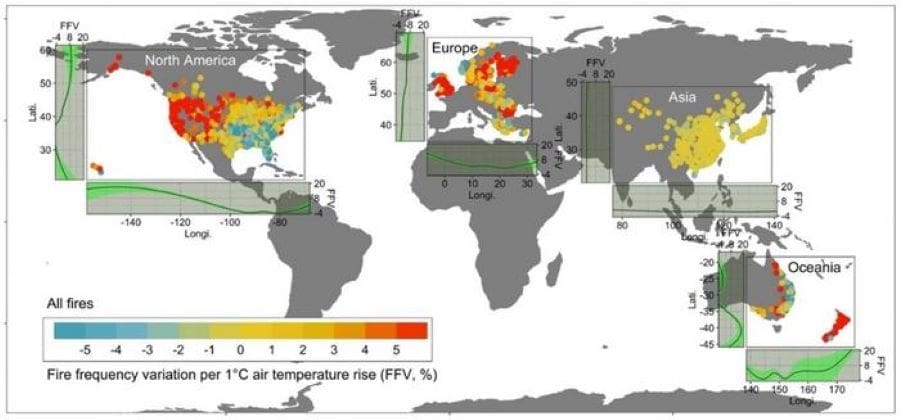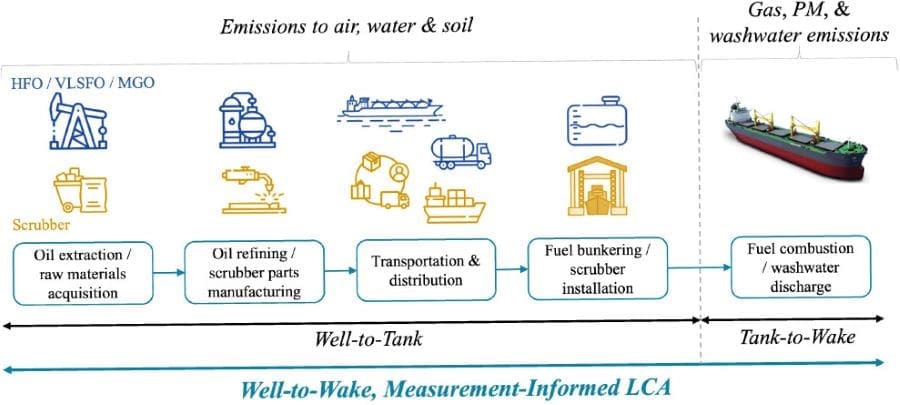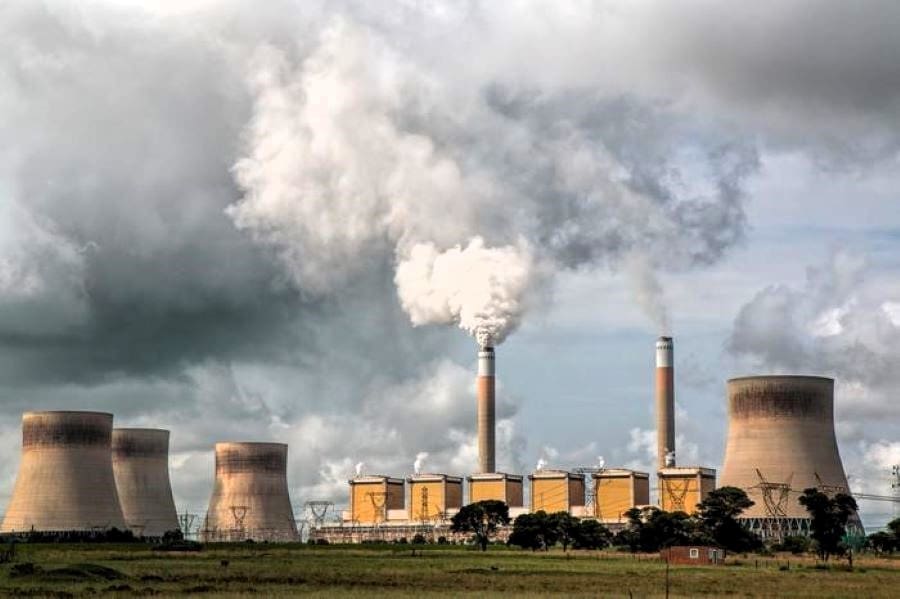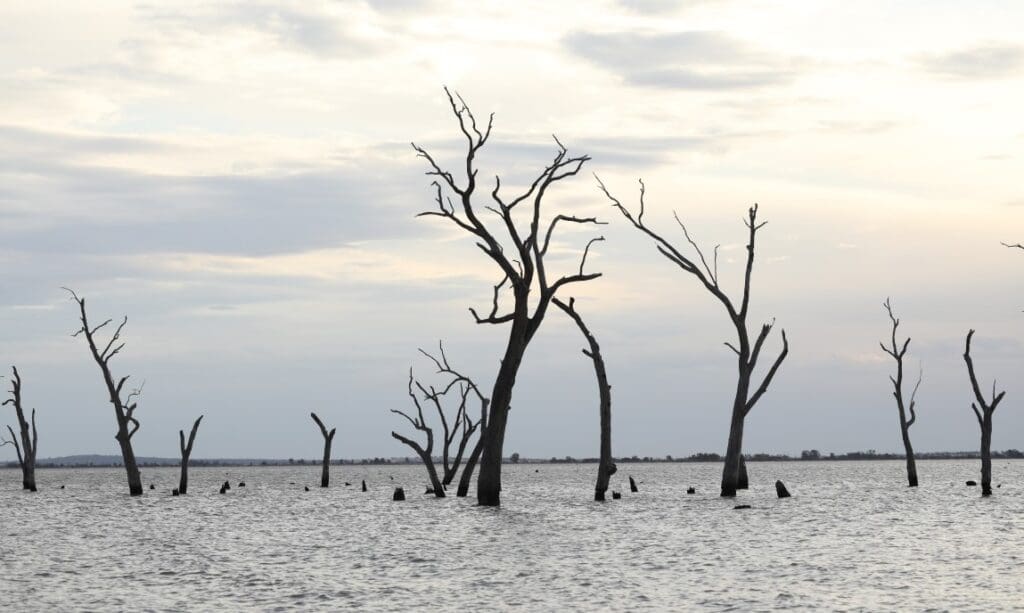Explore the latest insights from top science journals in the Muser Press daily roundup, featuring impactful research on climate change challenges.
In brief:
USTC unveils impact mechanism of climate change on urban fire risks
A research team led by Prof. Shi Long and Prof. Zhang Heping from the University of Science and Technology of China (USTC) of Chinese Academy of Sciences (CAS) established the most comprehensive city-level fire incident database to date, covering 20.6% of the global population and quantified the intrinsic link between climate change and urban fire risks.
The study was published in Nature Cities.
It is estimated that fires worldwide cause 50,000 deaths and 170,000 injuries annually. There is an urgent need in understanding changes in fire incident frequency when it comes to develop climate-adaptive strategies. While the impact of climate warming on wildfires has been well established, its influence on urban fire risks remains unclear.

The research team collected fire incident data from 2,847 cities worldwide, unveiling the impact mechanisms of climate change on different types of urban fires. Their findings revealed a parabolic relationship between building fire frequency and rising temperatures, with the lowest frequency occurring at the thermal comfort temperature of approximately 24.0°C.
Additionally, for every 1°C increase in temperature, vehicle and outdoor fire frequencies rose by 2.7% and 4.7%, respectively. Projections under the SSP5-8.5 climate scenario suggested that by 2100, building fire frequency may decrease by 4.6%, while vehicle and outdoor fire incidents could increase by 11.6% and 22.2%, respectively.
Between 2020 and 2100, global warming might directly result in 335,000 fire-related deaths and 1.153 million injuries. Although achieving the 1.5°C climate target could reduce fire-related casualties under the SSP5-8.5 scenario by 50%, the numbers would still be high.
The study provided quantitative recommendations for the allocation and reallocation of national firefighting budgets, guiding climate adaptation strategies. The researchers highlighted the need for different mitigation strategies for various types of fire incidents under global warming.
By implementing regional, timely, and precise firefighting resource planning, potential strategies could be directly applied to reduce fire-related casualties and property losses.
Given the current lack of urban-specific fire risk indices, the study could also help develop tailored fire risk indices for different countries or cities. laying a theoretical foundation for the planning, precise allocation and response strategies of firefighting resources.
Journal Reference:
Shi, L., Wang, J., Li, G. et al., ‘Increasing fire risks in cities worldwide under warming climate’, Nature Cities 2, 254–264 (2025). DOI: 10.1038/s44284-025-00204-2
Article Source:
Press Release/Material by University of Science and Technology of China (USTC) | CAS
Burning heavy fuel oil with scrubbers is the best available option for bulk maritime shipping
When the International Maritime Organization enacted a mandatory cap on the sulfur content of marine fuels in 2020, with an eye toward reducing harmful environmental and health impacts, it left shipping companies with three main options.
They could burn low-sulfur fossil fuels, like marine gas oil, or install cleaning systems to remove sulfur from the exhaust gas produced by burning heavy fuel oil. Biofuels with lower sulfur content offer another alternative, though their limited availability makes them a less feasible option.
While installing exhaust gas cleaning systems, known as scrubbers, is the most feasible and cost-effective option, there has been a great deal of uncertainty among firms, policymakers, and scientists as to how “green” these scrubbers are.
Through a novel lifecycle assessment, researchers from MIT, Georgia Tech, and elsewhere have now found that burning heavy fuel oil with scrubbers in the open ocean can match or surpass using low-sulfur fuels, when a wide variety of environmental factors is considered.

The scientists combined data on the production and operation of scrubbers and fuels with emissions measurements taken onboard an oceangoing cargo ship.
They found that, when the entire supply chain is considered, burning heavy fuel oil with scrubbers was the least harmful option in terms of nearly all 10 environmental impact factors they studied, such as greenhouse gas emissions, terrestrial acidification, and ozone formation.
“In our collaboration with Oldendorff Carriers to broadly explore reducing the environmental impact of shipping, this study of scrubbers turned out to be an unexpectedly deep and important transitional issue,” says Neil Gershenfeld, an MIT professor, director of the Center for Bits and Atoms (CBA), and senior author of the study.
“Claims about environmental hazards and policies to mitigate them should be backed by science. You need to see the data, be objective, and design studies that take into account the full picture to be able to compare different options from an apples-to-apples perspective,” adds lead author Patricia Stathatou, an assistant professor at Georgia Tech, who began this study as a postdoc in the CBA.

Stathatou is joined on the paper by Michael Triantafyllou, the Henry L. and Grace Doherty Professor in Ocean Science and Engineering in the Department of Mechanical Engineering, and others at the National Technical University of Athens in Greece, Naias Laboratories, and the maritime shipping firm Oldendorff Carriers.
The research was published in Environmental Science and Technology.
Slashing sulfur emissions
Heavy fuel oil, traditionally burned by bulk carriers that make up about 30 percent of the global maritime fleet, usually has a sulfur content around 2 to 3 percent. This is far higher than the International Maritime Organization’s 2020 cap of 0.5 percent in most areas of the ocean and 0.1 percent in areas near population centers or environmentally sensitive regions.
Sulfur oxide emissions contribute to air pollution and acid rain, and can damage the human respiratory system.
In 2018, fewer than 1,000 vessels employed scrubbers. After the cap went into place, higher prices of low-sulfur fossil fuels and limited availability of alternative fuels led many firms to install scrubbers so they could keep burning heavy fuel oil.
Today, more than 5,800 vessels utilize scrubbers, the majority of which are wet, open-loop scrubbers.
“Scrubbers are a very mature technology. They have traditionally been used for decades in land-based applications like power plants to remove pollutants,” Stathatou says.
A wet, open-loop marine scrubber is a huge, metal, vertical tank installed in a ship’s exhaust stack, above the engines. Inside, seawater drawn from the ocean is sprayed through a series of nozzles downward to wash the hot exhaust gases as they exit the engines.
The seawater interacts with sulfur dioxide in the exhaust, converting it to sulfates — water-soluble, environmentally benign compounds that naturally occur in seawater. The washwater is released back into the ocean, while the cleaned exhaust escapes to the atmosphere with little to no sulfur dioxide emissions.
But the acidic washwater can contain other combustion byproducts like heavy metals, so scientists wondered if scrubbers were comparable, from a holistic environmental point of view, to burning low-sulfur fuels.
Several studies explored toxicity of washwater and fuel system pollution, but none painted a full picture.
The researchers set out to fill that scientific gap.
A “well-to-wake” analysis

The team conducted a lifecycle assessment using a global environmental database on production and transport of fossil fuels, such as heavy fuel oil, marine gas oil, and very-low sulfur fuel oil. Considering the entire lifecycle of each fuel is key, since producing low-sulfur fuel requires extra processing steps in the refinery, causing additional emissions of greenhouse gases and particulate matter.
“If we just look at everything that happens before the fuel is bunkered onboard the vessel, heavy fuel oil is significantly more low-impact, environmentally, than low-sulfur fuels,” she says.
The researchers also collaborated with a scrubber manufacturer to obtain detailed information on all materials, production processes, and transportation steps involved in marine scrubber fabrication and installation.
“If you consider that the scrubber has a lifetime of about 20 years, the environmental impacts of producing the scrubber over its lifetime are negligible compared to producing heavy fuel oil,” she adds.
For the final piece, Stathatou spent a week onboard a bulk carrier vessel in China to measure emissions and gather seawater and washwater samples. The ship burned heavy fuel oil with a scrubber and low-sulfur fuels under similar ocean conditions and engine settings.
Collecting these onboard data was the most challenging part of the study.
“All the safety gear, combined with the heat and the noise from the engines on a moving ship, was very overwhelming,” she says.
Their results showed that scrubbers reduce sulfur dioxide emissions by 97 percent, putting heavy fuel oil on par with low-sulfur fuels according to that measure. The researchers saw similar trends for emissions of other pollutants like carbon monoxide and nitrous oxide.
In addition, they tested washwater samples for more than 60 chemical parameters, including nitrogen, phosphorus, polycyclic aromatic hydrocarbons, and 23 metals.
The concentrations of chemicals regulated by the IMO were far below the organization’s requirements. For unregulated chemicals, the researchers compared the concentrations to the strictest limits for industrial effluents from the U.S. Environmental Protection Agency and European Union.
Most chemical concentrations were at least an order of magnitude below these requirements.
In addition, since washwater is diluted thousands of times as it is dispersed by a moving vessel, the concentrations of such chemicals would be even lower in the open ocean.
These findings suggest that the use of scrubbers with heavy fuel oil can be considered as equal to or more environmentally friendly than low-sulfur fuels across many of the impact categories the researchers studied.
“This study demonstrates the scientific complexity of the waste stream of scrubbers. Having finally conducted a multiyear, comprehensive, and peer-reviewed study, commonly held fears and assumptions are now put to rest,” says Scott Bergeron, managing director at Oldendorff Carriers and co-author of the study.
Ultimately, this study shows the importance of incorporating lifecycle assessments into future environmental impact reduction policies, Stathatou says.
“There is all this discussion about switching to alternative fuels in the future, but how green are these fuels? We must do our due diligence to compare them equally with existing solutions to see the costs and benefits,” she adds.
Journal Reference:
Patritsia M. Stathatou, Ievgenii Petrunia, Torsten Barenthin, George Gotsis, Paul Jeffrey, Christopher Fee, Scott Bergeron, Marios Tsezos, Michael Triantafyllou, and Neil Gershenfeld, ‘Marine Scrubbers vs Low-Sulfur Fuels: A Comprehensive Well-To-Wake Life Cycle Assessment Supported by Measurements Aboard an Ocean-Going Vessel’, Environmental Science & Technology (2025). DOI: 10.1021/acs.est.4c10006
Article Source:
Press Release/Material by Adam Zewe | Massachusetts Institute of Technology (MIT)
System for calculating the impacts of emissions by large European industrial plants is published
Based on data in the European Pollutant Release and Transfer Register and the life cycle approach, the Amalur EIS environmental information system, created by the Ekopol group of the University of the Basque Country (UPV/EHU), enables environmental impacts at national, regional and/or municipal level to be analysed. The researchers also analysed the results of data collected at industrial plants in the Basque Country between 2007-2022.
“Large industrial plants need to provide the administrations with data on their releases into the land, the water and the air, which the European Union records in the European Pollutant Release and Transfer Register (E-PRTR). However, this information is not very useful in its current form, so to analyse these data, we have created the Amalur EIS environmental information system to bring the impacts of all pollutants into a single indicator,” explained the UPV/EHU researcher Gorka Bueno.
The Amalur EIS system calculates the environmental impacts based on the information contained in the E-PRTR register; it uses data on releases into the land, air and water from 31,388 industrial plants across Europe between 2007-2022. It can also make calculations using 31 life cycle impact assessment methods, and includes 78 of the 91 pollutants regulated by the E-PRTR protocol.

It also takes into consideration various aspects of environmental impacts, such as climate change, toxicity to ecosystems and/or humans, tropospheric ozone generation, acidification, particle formation, etc. “We often focus on climate change, global warming, but we have to take into account that there are many other types of impacts and that, in addition to releases into the air, those into the water and the land also need to be borne in mind,” explained the Ekopol researcher.
Understanding the data in order to make decisions
As the member of the Ekopol research group Bueno explained, this system “converts and quantifies the emission data on industrial pollutants into environmental impacts”.
“Amalur EIS is a valuable tool for monitoring the transition to sustainability, especially in Europe. In fact, it provides an opportunity to obtain comprehensive information on the environmental impact, for example, to find out which facilities generate the greatest impacts in the economic sectors, and to identify economic sectors, etc.” The system aims to make the data available to the academic community, policy makers, companies and society.
So by using the methods recommended by the European Commission, including standardisation and weighting steps, the Ekopol researchers used the Amalur EIS system to analyse data on Europe and the Basque Country.
Climate change has the greatest weight in Europe’s total environmental impact (68.6%), and “out of all industrial activities, the energy sector exerts the greatest impact (59.5% of the total). Geographically, these two elements coincide in the German regions of Düsseldorf, Cologne and Brandenburg, resulting in a concentration of the greatest regional impacts in Europe. In fact, Germany is the country with the greatest impact, accounting for 20.3% of the total,” explained the UPV/EHU researcher. The information is presented in a very meaningful way on the Amalur EIS website.
Environmental impact of industrial plants in the Basque Country
To demonstrate the tool’s potential, the Ekopol researchers have drawn many conclusions from the data and produced a list. According to these results, “the Petronor plants (Muskiz, Bizkaia) generate the greatest impact (25% of what all the plants generate). The six main plants in the mineral industry (mainly cement industries) account for 16.9% of the total impact and the seven thermal power plants account for 17% of the total (the second most polluting plants are the two Total Energies combined cycle plants located in Castejón, Navarre).”
The next sector on the list is the waste treatment sector, which accounts for 12.5% of the total impact (the Galindo WWTP is the 5th most polluting plant, the Zabalgarbi incinerator the 12th, and the Artigas landfill is ranked 23rd).
Geographically, Bizkaia is the province with the greatest impact, accounting for 52% of the total impact and 10 of the 25 most polluting installations; Navarre has 7 installations and contributes 23.7% of the total impact; Gipuzkoa has 5 installations accounting for 17.8% of the total; Álava has 3 installations and 6.3% of the total; the Continental Basque Country only 0.5% of the total and the first polluting installation is ranked 55th.
***
This piece of work was produced by Jon Iñaki Sasia-Santos, Gorka Bueno-Mendieta and Iker Etxano-Gandariasbeitia, members of the UPV/EHU’s Ekopol research group; it is a section of Sasia-Santos’ PhD thesis.
Journal Reference:
Sasia, I., Bueno, G. & Etxano, I., ‘Amalur EIS: a system for calculating the environmental impacts of industrial sites from E-PRTR records’, Environmental Monitoring and Assessment 197, 163 (2025). DOI: 10.1007/s10661-024-13565-3
Article Source:
Press Release/Material by University of the Basque Country
China’s natural terrestrial ecosystems: a significant source and sink of methane and nitrous oxide
China’s natural terrestrial ecosystems (NTEs), including forests, grasslands, shrubs and wetlands, play a crucial role in the global methane (CH4) and nitrous oxide (N2O) budgets. These ecosystems are both sources and sinks of these potent greenhouse gases, which have a significant impact on global warming.
A new study, led by Dr. Tingting Li from the Chinese Academy of Sciences (CAS), provides a comprehensive review of CH4 and N2O emissions and uptake in China’s NTEs over the past four decades.

The study, published in National Science Review, reveals that China’s NTEs were significant sources of CH4 and N2O emissions between 1980 and 2020, with an accumulated global warming potential (GWP) of 5.55 Pg CO2-equivalent. The research team used a multi-model approach to estimate CH4 emissions from natural wetlands, CH4 uptake from forests, grasslands, and shrublands, and N2O emissions from these ecosystems. The findings show that while CH4 uptake by forests, grasslands and shrublands nearly offsets CH4 emissions from wetlands, the net warming effect is primarily driven by N2O emissions.
The study also highlights the impact of climate change and land-use changes on greenhouse gas emissions. Rising temperatures and increased precipitation have enhanced CH4 emissions from wetlands, while atmospheric nitrogen deposition has driven increases in N2O emissions. Human activities, such as wetland conversion and forest expansion, have also significantly influenced the spatiotemporal patterns of greenhouse gas emissions.
Dr. Li and her team emphasize the need for integrated planning in ecosystem restoration projects to minimize non-CO2 emissions. They recommend prioritizing grassland restoration in regions like Inner Mongolia and the Tibetan Plateau, where it can enhance CH4 uptake and contribute to biodiversity conservation. Wetland restoration should focus on areas with low CH4 fluxes, such as coastal wetlands, to balance greenhouse gas emissions with ecosystem services like water purification and flood control.
This study provides a clearer understanding of the spatiotemporal patterns of CH4 and N2O emissions in China’s NTEs and offers valuable insights for policymakers aiming to mitigate greenhouse gas emissions while promoting sustainable land use practices.
Journal Reference:
Tingting Li, Xinyi Liu, Jiahui Tian, Wenping Yuan, Xuhui Wang, Xiu-Qun Yang, Songbai Hong, Yilong Wang, Qiuan Zhu, Lijun Yu, Jiangzhou Xia, Han Xiao, Minqi Liang, Shihua Li, Zimeng Li, Yingxuan Wang, Kerou Zhang, Min Xu, Zhangcai Qin, ‘Methane and nitrous oxide budget for Chinese natural terrestrial ecosystems’, National Science Review 12, 4, nwaf094 (2025). DOI: 10.1093/nsr/nwaf094
Article Source:
Press Release/Material by Science China Press
Featured image credit: Gerd Altmann | Pixabay




